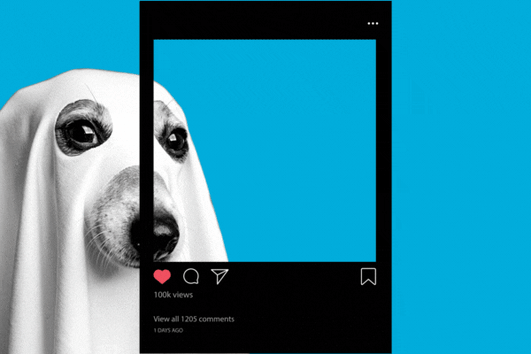Dark social, a term coined by Alexis Madrigal, is a phenomenon in the marketing world that refers to the sharing of content through private channels. Nothing spooky about that, right? I promise it's not about finding leads through some sort of summoning ritual.

Basically, its when people share content through mediums such as messaging apps or email, rather than public social media platforms like Facebook or Twitter. No capes or ritual sacrifices here.
This type of sharing is not easily tracked by web analytics tools, making it difficult for marketers to understand the full extent of consumer behavior and preferences. That's what makes it dark.
Despite its elusive nature, dark social traffic can be monitored through the use of social share buttons and other analytical tools available to marketers.
It's worth noting that many consumers prefer sharing content through private channels because it feels more natural and allows them to be themselves.
In fact, 48% of respondents who might hesitate to share content on a public platform said they feel more comfortable using dark social channels.
For marketers, understanding the importance of dark social can help to uncover a valuable untapped market.
By implementing strategies that target private channels, such as creating content that is easily shareable via messaging apps, brands can gain a better understanding of their audience's preferences and behavior, and ultimately drive engagement and conversions.
But let's take a closer look.
What is Dark Social?
In the world of marketing, "dark social" refers to web traffic that comes from popular modern distribution channels, but is difficult to accurately track.
This makes it challenging for companies to have direct visibility into the impact of this traffic, especially in places where B2B buyers are highly active.
Other terms used to describe this phenomenon include dark traffic, dark social media, and dark funnel, although the latter is focused on intent data rather than specific channels.
Word-of-mouth marketing has long been a crucial part of many firms' business generation efforts, and it has evolved to include social media over the years.
Dark social refers to conversations that reference a brand but are impossible to track. The term "dark" simply refers to the difficulty in tracking them, and there is nothing nefarious about them.
As such, it's important for marketers to understand the impact of dark social and find ways to track it as much as possible.
By utilising social share buttons and other analytical tools, businesses can gain insights into the content being shared through private channels, and adjust their strategies accordingly to better connect with their audience and drive engagement.
Why Does it Matter?
You might be thinking "Oh well, my social media's doing great. We got three likes on that TikTok the other day, the one of the CEO dancing to 'Don't Stop Believin'". It works for us!"
That sounds great, but without considering dark social, you're missing out.
The importance of "dark social" for brands cannot be overstated.
In fact, 84% of outbound sharing from publishers' and marketers' websites occurs through private channels such as email, social networks, and instant messaging.
These channels have only continued to expand and become more relevant over time, making them essential for reaching your ideal customer profiles, especially in B2B.
Why is this so important? Because it's how buying decisions are made. It's how you create demand for your product or services, and where buyers go to learn and discover with industry peers.
People trust people, and rely on recommendations and influence from their peers when consuming and making purchases. While search engines and review sites still carry some influence, it's not as much as many people tend to think.
Employee Advocacy
An employee advocacy strategy is a powerful way to leverage "dark social" influence.
By encouraging employees to create and share content to their personal networks, brands can benefit from both direct and indirect influence. When employees share links to the company website, advocacy platforms and UTMs can provide insights into the ROI generated directly.
However, it's important to avoid having employees simply blast out company links or blog posts.
Audiences expect more from brands, so a comprehensive distribution strategy should include various content mediums, including third-party content. While this approach may not be entirely measurable, it can create demand and word-of-mouth influence that generates massive brand awareness, increases inbound opportunities, and shortens sales cycles.
Tracking and Measuring Dark Social: A Guide
The challenge with dark social is the inability to trace the origin of traffic, which can be classified as "direct" or "other," without additional information to identify prospects.
This poses a strategic problem for decision-making, as the web data provided may not be entirely reliable, and sales generated from this traffic cannot be attributed to a specific channel or activity.
To shed light on dark social, you may wonder how to measure the results and prove their value to leadership.
Let's jump into some bullet points, shall we? Well some ways you can measure dark social include:
- One way to measure dark social is by using unique tracking URLs (UTMs) that include campaign parameters. These can help you track clicks and conversions from different sources, including dark social.
- Another method is to use social listening tools that monitor social media conversations and mentions of your brand, even in private channels.
- You can also use referral data from Google Analytics to identify traffic sources and see how much is classified as direct or other, which could potentially be dark social.
- It's important to have a consistent naming convention for UTMs and to regularly review and update them to ensure accurate tracking.
- Additionally, using a customer relationship management (CRM) system can help you track and analyze customer interactions across different channels, including dark social.
- Finally, it's important to have a comprehensive measurement strategy that includes both quantitative and qualitative data to understand the impact of dark social on your marketing efforts.
